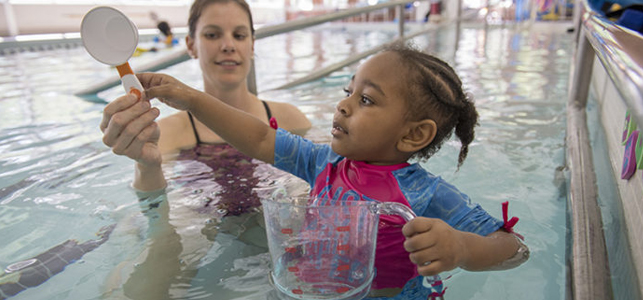
Using aquatic therapy for physical development
Watching a child playing around on a pool noodle, you might be surprised to know just how much is going on physically. Even if it looks like they’re just noodling around, they’re building strength and developing physical skills. It’s what’s going on with their muscles and joints while they’re moving around in the water that’s the basis for aquatic therapy – a special form of therapy that takes place in a pool.
The wonder of water
A pool offers a unique environment for developing physical skills. The body’s tendency to float or rise when in water (buoyancy) provides weightlessness. When there’s less weight to carry, joints and muscles tend to move more easily. This buoyancy is the ultimate platform to be able to access any part of the body. The ease of movement buoyancy allows, and the gentle resistance being in water provides, are used in activities that help achieve therapy goals.
Typical goals for the children we work with include improving muscle tone, strength, endurance, flexibility, balance and coordination, as well as developing and improving specific motions and movements. The sessions take place in a therapeutic pool, which is a pool that’s heated between 91-93 degrees. Being in this warm water is relaxing and can help muscles and joints move with less pain. Moving with less (or no) pain allows a child to more easily participate in therapy activities.
How aquatic therapy works and who can benefit
Aquatic therapy can be a stand-alone activity or be used in conjunction with traditional land-based therapy. Therapy techniques can help a child improve specific motions, movements or other skills when they’re in the water with the goal of transferring improved skills to what they’re doing on land. These techniques can also be used to help a child maintain the skills they gain.
For a child with limited motion, muscle weakness, or who’s regaining movement after orthopaedic surgery, the ease of movement that being in water provides can support them in completing therapy activities that practice and strengthen specific movements. The movement can be within the limited motion they have, or allow for them to increase that motion. When they’re able to perform the functional movement in the water – raising their arms, for example – they transfer this new skill to an everyday activity they do on land, such as putting on a shirt.
With a pain condition like arthritis, being in the water allows the child to move and play with less pain so they’re less likely to ask for a rest break or say “I don’t want to do that because it’s going to make me sore later.” When they’re moving, they’re strengthening, and when they don’t need rest breaks, they’re building endurance.
The benefits of aquatic therapy can include much more than movement. For example, a child with sensory defensiveness/avoidance can be recommended for aquatics and a typical activity may include easing the child into the water. Sessions may start at the entrance ramp/steps and slowly ease into the pool as a child’s comfort level for the water improves.
Not just noodling around
Our physical and occupational therapists who provide aquatic therapy have specific education in therapeutic exercises in the aquatic environment. They incorporate specially designed activities into sessions to target specific skills and help children reach therapy goals personalized to their needs and abilities. This is where things like “playing” on a pool noodle come in.
A noodle can be used in a variety of ways. Activities like riding the horse, where a child sits on the pool noodle and uses their legs to propel forward through the water, develops strength, endurance and coordination. Encouraging the child to maintain their balance while their weight shifts as they move themselves forward on the noodle (“No leaning! Try to stay upright as you move your legs.”) works on balance. Having the child alternate their leg movements to propel themselves forward, rather than using a bouncing motion (“Try to move like you’re riding a bike!”), helps develop, or further develop, coordination.
Aquatic therapy can help with fine motor skills as well. Other activities you might see during sessions include things like scooping and dumping water using a cup, spoon or other equipment to help with gaining wrist movement.
This special type of therapy can bring purposeful fun to a challenging situation. And just being in the water has proven to be a motivator too: We’ve found that many of the kids we work with are more willing to participate when they’re in the water, than on land. Offering this unique (and motivating!) option is one of the many ways our therapy team helps those we serve achieve their goals.
– Lauren Champion, occupational therapist, and Jennifer Hawley, physical therapist
Aquatic therapy program details – All children we see require a therapeutic plan of care with specific goals to participate in aquatics. A child does not necessarily have to be seen on land to be seen for aquatics, but a land-based assessment must be completed to formulate appropriate goals. We offer seven-week sessions and each appointment is approximately 50 minutes. Due to facility requirements, participants must be toilet trained and are typically over age 3. Other aquatic programs may have their own limitations and rules for participants. Visit our aquatic therapy page to learn more.
Note: While aquatic therapy is not intended to teach a child how to swim, it may provide foundational skills needed for swimming.
